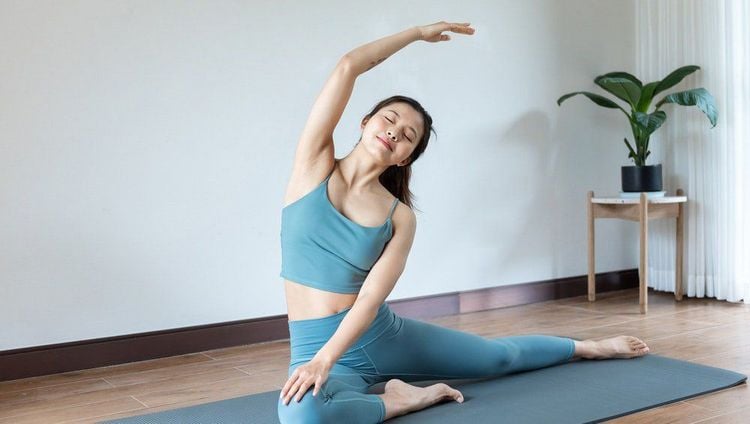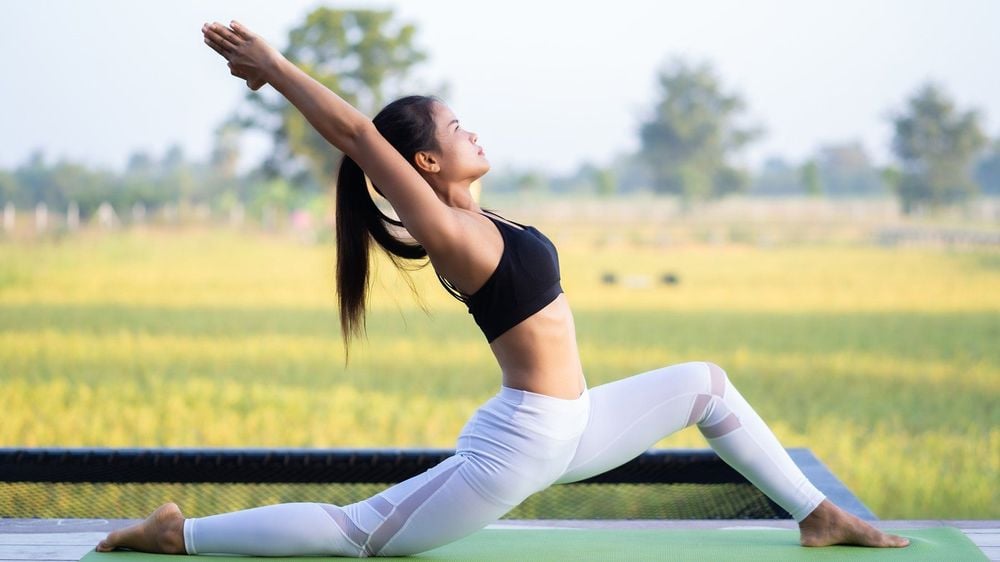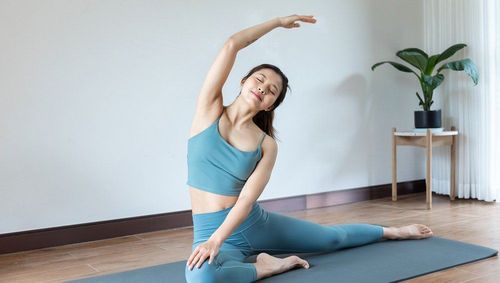This is an automatically translated article.
The purpose of yoga is to build strength, awareness and harmony in both mind and body. While there are more than 100 different types or schools of yoga, most sessions typically include breathing exercises, meditation, and poses that stretch and flex different muscle groups. Maintaining a regular practice of light or heavy yoga can provide benefits for physical and mental health.
1. Benefits of Yoga
If you are a yoga enthusiast, you may have noticed some of the health benefits that yoga can bring. Regular yoga practice can help practitioners sleep better, get sick less often, and feel better both physically and mentally. But if you've ever tried talking to a novice about the benefits of yoga, you may find that explanations like "it increases blood circulation and will make the practitioner feel better" or "yoga brings lots of health benefits” would make these people feel skeptical or disinterested.
Researchers are looking to dig deeper into the health benefits of yoga. Many Western scientists have begun to provide some specific clues as to how yoga works to improve health, heal pain, and prevent disease. Once you understand them, you'll be more motivated to get ready to exercise and you probably won't feel so constrained the next time someone wants proof of the health benefits. yoga can bring.
Experiences about the benefits of practicing yoga, especially those about the healing power of yoga, have been shared in a very real way. One patient shared: “A few weeks before a trip to India in 2002 to learn about yoga therapy, I had numbness and tingling in my right hand. After first looking at scary things like brain tumors and multiple sclerosis, I discovered the cause of the symptoms was thoracic outlet syndrome, a blockage of nerves in the neck and chest. mine. Despite the unpleasant symptoms, I realized how my condition could improve during the trip. While visiting various therapeutic yoga centers, I will be personally assessed and treated by the various professionals I choose to observe. I can try their suggestions and see what works for me. While this is not exactly a controlled science experiment, I know that such hands-on learning can teach me things that I may not understand.”
“... For over a year, I was symptom free. The change and proper yoga practice has helped me a lot in life. At the Vivekananda ashram just outside of Bangalore, S. Nagarathna, suggested breathing exercises in which I imagined bringing prana (an important source of energy) to my upper right chest. Other therapies include: asanas, pranayama, meditation, chanting, lectures on philosophy, and various kriyas (inner purification practices).

Các nhà nghiên cứu đang muốn tìm hiểu sâu hơn về những lợi ích cho sức khỏe mà yoga có thể mang lại
2. Level and intensity of yoga practice
New training methods appear, exist for a while and are gradually forgotten, almost no other training program is as durable as yoga. It has existed for more than 5,000 years. Yoga not only burns calories but also helps to tone muscles. It's a mind-body workout that combines strengthening and stretching poses with deep breathing and meditation or relaxation.
There are more than 100 different forms of yoga practice. Some are fast-paced and intense. Other forms are gentler and more relaxing. Examples of different forms of yoga include:
Hatha: A form related to yoga that combines a series of basic movements with breathing; Vinyasa: A form of yoga consisting of a series of interconnected poses; Power: A faster, more intense workout that builds muscle; Ashtanga: A series of poses, combined with a special breathing technique; Bikram: Also known as "hot yoga", consists of a series of 26 rather difficult poses to be performed in a room heated to high temperatures; Iyengar. A type of yoga that uses props such as blocks, straps, and chairs to help the practitioner move the body into the proper position. The variation in the level and type of yoga practice intensity depends on the form of yoga an individual chooses. Techniques like hatha and iyengar yoga are gentler and slower, while bikram and power yoga are faster and have more difficult movements.
Areas of the body that yoga targets include:
Muscles: There are yoga poses to target major muscle groups. The practitioner will clenched his fist, then prop himself up on one arm and perform a side plank. To really burn the mid-abs, exercisers can do boat pose, in which they balance on the "sitting bone" (the bony protrusion at the base of the pelvis) and between their legs in the air. Arms: With yoga, you don't build arm strength with weights or machines, but with your own body weight. Some poses, such as plank, evenly distribute your weight between your arms and legs. Other poses, like crane and crow pose, challenge your arms even more by making them support your entire body weight. Legs: Yoga poses work on all sides of the legs, including the quads, hips, and thighs. Buttocks: Yoga squats, bridges, and warrior poses involve deep knee bends, giving you a nicer back. Back: Moves like face down dog, child pose, and cat/cow pose help stretch your back muscles. It's no surprise that many studies show that yoga can be good for back pain relief. There are many types of yoga, from gentle hatha to intense yoga. All types bring your training to a whole new level of mind-body connection. It can help you relax and focus while gaining flexibility and strength. Yoga can also improve people's mood. While there are plenty of books and instructional DVDs on yoga, it's also a good idea to invest in some classes with a good instructor who can show you how to practice the poses. For many people, there are several types of yoga specifically tailored to their needs and fitness level. It's a great option if you want a holistic approach to mind and body strength.

Yoga có thể mang lại cho bạn sự dẻo dai, khỏe mạnh mà không gây thêm căng thẳng cho các khớp
Yoga is not for you if you like a fast and competitive workout. Be open-minded, as you can reap physical and mental benefits by adding some yoga practice to your fitness plan, even if it's not your main workout.
Yoga is a great practice for people with diabetes, high blood pressure, high cholesterol, or metabolic heart disease. It gives the practitioner strength, flexibility and proper body awareness. You'll also need to do some aerobic exercise (like walking, biking, or swimming) if you don't do yoga. If you have high blood pressure, diabetes or heart problems, talk to your doctor about exercises you can do. You may need to avoid certain positions, such as lying upside down or requiring more balance than you currently have. A gentle yoga program, combined with a gentle aerobic activity like walking or swimming, may be the best way to start.
Yoga can also give you flexibility and strength without putting extra stress on your joints. You get the added benefit of a mind-body approach that can help you relax and energize. If you're pregnant, yoga can help you relax, stay healthy, and stay in shape. If you're new to yoga or have any health- or pregnancy-related issues, talk to your doctor before deciding to give it a try. Look for an instructor experienced in teaching prenatal yoga. The practitioner will need to make some adjustments as your baby and belly grow and your center of gravity changes. After the first trimester, don't do any position that puts your body on your back. And don't try to stretch any longer than you did before you got pregnant. The pregnancy hormones will loosen your joints and make you more susceptible to injury. During pregnancy, you need to avoid positions that put pressure on your abdomen or low back. Do not practice "hot" yoga, where the room temperature is very high.
In the current period, although research on the effects of yoga on health is appearing more than ever, experts say that most of the research is still in the early stages. But the quality of yoga exercises is gradually improving, besides the types of yoga practice are also becoming more and more diverse, from exercises that require strength and complex movements to exercises. Gentle exercise for all subjects of different ages. Experts predict that in the next decade people will know much more about what yoga can do for our minds as well as our bodies.
Along with daily yoga practice, regular health check-ups will help to screen for diseases effectively and safely. Currently, Vinmec is implementing a lot of general health checkup packages suitable for each age, gender and specific needs of customers with very favorable price policy, including:
Work general health checkup package permit- issue work permit Child Health Checkup Package Standard General Health Checkup Package Special General Health Checkup Package VIP General Health Checkup Package Diamond Health Checkup Package Advantages of the Vinmec's health check-up package means that customers will be screened and screened by a system of modern equipment to help support the best diagnosis today such as PET/CT, MRI, CT 640, machine systems. The world's leading advanced ultrasound, international standard laboratory system,... After a general examination, if any diseases are detected, customers can use services from other specialties at hospital with outstanding quality of treatment.
Please dial HOTLINE for more information or register for an appointment HERE. Download MyVinmec app to make appointments faster and to manage your bookings easily.
Reference sources: yogajournal.com, webmd.com












